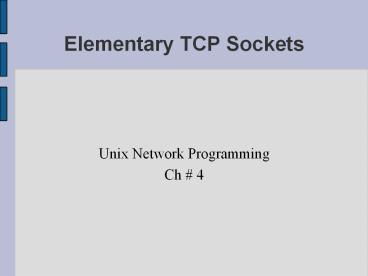Elementary TCP Sockets - PowerPoint PPT Presentation
1 / 15
Title:
Elementary TCP Sockets
Description:
Elementary TCP Sockets Unix Network Programming Ch # 4 Elementary Socket functions Socket Function To perform network I/O, first thing a process must do is call the ... – PowerPoint PPT presentation
Number of Views:662
Avg rating:3.0/5.0
Title: Elementary TCP Sockets
1
Elementary TCP Sockets
- Unix Network Programming
- Ch 4
2
Elementary Socket functions
3
Socket Function
- To perform network I/O, first thing a process
must do is call the socket function
include ltsys/socket.hgt int socket(int family,
int type, int protocol) - returns non-negative
descriptor if ok, -1 on error
4
Connect funciton
- The connect function is used by a TCP client to
establish a connection with a TCP server - include ltsys/socket.hgt
- int connect(int sockfd, const struct sockaddr
servaddr, socklen_t addrlen) - Returns 0 if ok, -1 on error
- Sockfd is a socket descriptor returned by the
socket function - 2nd 3rd args are the socket address structures,
must contain the address of the server to
communicate with - The client does not have to call bind
- The kernel chooses both an ephemeral port and the
source IP address if necessary.
5
Bind function
- The bind funtion assigns a local protocol address
to a socket. - With IP, combination of 32-bit (IPv4 or 128-bit
for IPv6) address, along with a 16-bit TCP or UDP
port number. - include ltsys/socket.hgt
- int bind(int sockfd, const struct sockaddr
myaddr, socklen_t addrlen) - Servers bind to their well-known port when they
start - A process can bind a specific IP address to its
socket - Normally, however, a client does not bind an IP
address, so that client can then respond on any
interface available on the host
6
Listen function
- The listen function is called only by a TCP
server and it performs 2 actions - Converts an unconnected (active) socket into a
passive socket (indicates kernel should accept
incoming connect requests directed to this socket - 2nd argument specifies the maximum number of
connections kernel should queue for this socket - include ltsys/socket.hgt
- int listen(int sockfd, int backlog)
7
Listen function
- Normally called after both the socket and bind
function, only by the server of course - Backlog - for a given listening socket, the
kernel maintains 2 queues - An incomplete connection queue, which contains an
entry for each SYN that has arrived from a client
for which server is awaiting completion of the
TCP 3-way handshake - A completed connection queue, entry for each
client with whom 3-way handshake has completed. - Figure 4.7, pg. 105
8
(No Transcript)
9
Accept function
- Accept is called by a TCP server to return the
next completed connection from the front of the
completed connection queue. - If completed queue is empty, the process is put
to sleep. - include ltsys/socket.hgt
- int accept(int sockfd, struct sockaddr cliaddr,
socklen_t addrlen) - Returns non-negative descriptor if OK, -1 on
error - The cliaddr and addrlen args are used to return
the protocol address of the connect peer process
(the client).
10
Fork and exec functions
- We will look at building a concurrent server
- Need to create a new child process to handle each
incomming client request/transaction - fork function is the only way in Unix to create a
new process - include ltunistd.hgt
- pid_t fork(void)
- Returns 0 in child, process ID of child in
parent, -1 on error - Called once but returns TWICE
- Once in the parent process (returns child process
id), - and once in the child process (return of 0)
11
More Forking
- All descriptors open in the parent before the
call to fork() are shared with the child after
fork returns. - Including the connected socket file description
returned by accept
12
Exec function
- Only way in which an executable program file on
disk can be executed in Unix is for an existing
process to call one of the 6 exec functions
13
Concurrent Servers
- When a client request can take some time to
service, don't want to take away time for
handling connections to service a single client - Handle the communication with multiple clients at
the same time - Simplest way to write a concurrent server under
Unix is to fork a child process to handle each
client.
14
Concurrent Servers
15
Close function
- Close() function used to close a socket and
terminate a TCP connection - include ltunistd.hgt
- int close(int sockfd)
- Returns 0 if ok, -1 on error
- Default action of close with a TCP socket
description is to mark the socket as closed and
return tot he process immediately. - Socket descriptor is no longer usable to the app
process at this point - But TCP will try to send any data that is already
queued, and once flushed begin the normal TCP
termination sequence.































